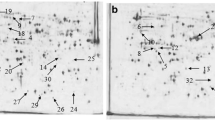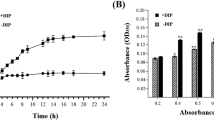Abstract
Vibrio tubiashii (Vt) infection is a common cause of severe diseases in aquaculture. In order to confirm the pathogenicity of Vt in ivory snail Babylonia areolata, the Vt strains were analyzed using isobaric tags for relative and absolute quantitation (iTRAQ) technology. Thus, 2717 proteins were identified. Fifty-three upregulated proteins and 52 downregulated proteins were found in the high-virulence strain (BBXP), compared with the low-virulence strain (FB13). The results suggested that the membrane proteins, such as type I secretion outer membrane protein, TolC, lipoprotein, efflux system proteins, iron-regulated protein A, and several virulence-associated proteins, were differentially regulated. Analysis of the different proteins showed that many were associated with quorum sensing regulation, and that there were significant differences between the highest-virulence strain and the lowest-virulence strain, including differences in their transcription factors, chemotaxis proteins, transport proteins, and proteins involved in iron homeostasis. Cell division proteins and cell repair proteins differed most significantly and the levels of these proteins in the virulent BBXP strain were much higher. The cell pathways related to stress responses and cell damage and the apoptosis pathways were significantly upregulated. This is the first study to identify differential proteins between Vt strains with different virulence levels. It will provide an important foundation for understanding the molecular mechanisms of the pathology of Vt in mollusks.






Similar content being viewed by others
Data availability
All data are available from the corresponding author on reasonable request.
References
Baumann P, Schubert RHW (1984) Family II. Vibrionaceae. In: Krig NR, Holt JG (Eds.) Bergey's Manual of Systematic Bacteriology, 3rd. Williams and Wilkins Baltimore MD, pp 516–544
Charles M, Bernard I, Villalba A, Oden E, Houssin M (2019) High mortality of mussels in northern Brittany-Evaluation of the involvement of pathogens, pathological conditions and pollutants. J Invertebr Pathol 170(4):107308. https://doi.org/10.1016/j.jip.2019.107308
Dickerson J, Gooch-Moore J, Jacobs JM, Mott JB (2021) Characteristics of Vibrio vulnificus isolates from clinical and environmental sources. Mol Cellu Probe 56:101695. https://doi.org/10.1016/j.mcp.2021.101695
Dong HT, Taengphu S, Sangsuriya P, Charoensapsri W, Phiwsaiya K, Sornwatana T, Khunrae P, Rattanarojpong T, Senapin S (2017) Recovery of Vibrio harveyi from scale drop and muscle necrosis disease in farmed barramundi, Lates calcarifer in Vietnam. Aquaculture 473:89–96. https://doi.org/10.1016/j.aquaculture.2017.02.005
Doran KS, Nizet V (2004) Molecular pathogenesis of neonatal group B streptococcal infection: no longer in its infancy. Mol Microbiol 54(1):23–31. https://doi.org/10.1111/j.1365-2958.2004.04266.x
Dubert J, Aranda-Burgos JA, Ojea J, Barja JL, Prado S (2017) Mortality event involving larvae of the carpet shell clam Ruditapes decussatus in a hatchery: isolation of the pathogen Vibrio tubiashii subsp. europaeus. J Fish Dis 40(9):1185–1193. https://doi.org/10.1111/jfd.12593
Elston RA, Hasegawa H, Humphrey KL, Ildiko KP, Claudia CH (2008) Re-emergence of Vibrio tubiashii in bivalve shellfish aquaculture: severity, environmental drivers, geographic extent and management. Dis of Aqua Organ 82(2):119–134. https://doi.org/10.3354/dao01982
Gang L, Huang LX, Su YQ, Qin YX, Xu XJ, Zhao LM, Yan QP (2016) flrA, flrB and flrC regulate adhesion by controlling the expression of critical virulence genes in Vibrio alginolyticus. Emerg Microbes Infec 5(8):85. https://doi.org/10.1038/emi.2016.82
Hada HS, West PA, Lee JV, Stemmler J, Colwell RR (1984) Vibrio tubiashii sp. nov, a pathogen of bivalve mollusks. Interna J Syst Bacteriol 34(1):1–4. https://doi.org/10.1099/00207713-34-1-1
Kang CH, Kim YG, Oh SG, Mok JS, Cho MH (2014) So JS (2014) Antibiotic resistance of Vibrio harveyi isolated from seawater in Korea. Mar Pollut Bullet 86(1–2):261–265. https://doi.org/10.1016/j.marpolbul.2014.07.008
Khadria AS, Senes A (2013) The transmembrane domains of the bacterial cell division proteins FtsB and FtsL form a stable highest-order oligomer. Biochemistry 52(43):7542–7550. https://doi.org/10.1021/bi4009837
Kumar S, Tamura K, Nei M (2004) MEGA3: integrated software for molecular evolutionary genetics analysis and sequence alignment. Brief Bioinform 5:150–163. https://doi.org/10.1093/bib/5.2.150
Ling H, Zhao W, Wang RX, Wu KC, Wang JY (2018) Physical-chemical factors associated with the dynamic change of bacterial quantity of alimentary tract and environment in Babylonia areolate industrial aquaculture. Mar Environ Science 37(01):62–69. https://doi.org/10.13634/j.cnki.mes.2018.01.011
Ling H, Zhao W, Wang RX, Huang S, Wu KC, Wang JY (2019) The quantity variation of bacteria in Babylonia areolata aquaculture environment and its correlation and principal component analysis. Ecolog Science 38(02):30–137. https://doi.org/10.14108/j.cnki.1008-8873.2019.02.017
Liu XJ, Wang RX, Ling H, Yao T, Wang JY (2019) Studies on the pathogenic bacteria and their virulence factors of “acute death syndrome” in Babylonia areolata. Mar Environ Science 38(1):7–15. https://doi.org/10.13634/j.cnki.mes.2019.01.025
Nesta B, Spraggon G, Alteri C, Moriel DG, Rosini R, Veggi D, Smith S, Bertoldi I, Pastorello I, Ferlenghi I, Fontana MR, Frankel G, Mobley HLT, Rappuoli R, Pizza M, Serino L, Soriani M (2012) FdeC, a novel broadly conserved Escherichia coli adhesin eliciting protection against urinary tract infections. Mbio 3(2):e00010–e00012. https://doi.org/10.1128/mBio.00010-12
Prado S, Romalde JL, Montes J, Barja J (2005) Pathogenic bacteria isolated from disease outbreaks in shellfish hatcheries. First description of Vibrio neptunius as an oyster pathogen. Dis Aquat Orga 67(3):209–215. https://doi.org/10.3354/dao067209
Prado S, Dubert J, Barja LJ (2015) Characterization of pathogenic vibrios isolated from bivalve hatcheries in Galicia, NW Atlantic coast of Spain Description of Vibrio tubiashii subsp. europaensis subsp. nov. Syst Appl Microbiol 38(1):26–29. https://doi.org/10.1016/j.syapm.2014.11.005
Schwaner C, Barbosa M, Connors P, Park TJ, de Silva D, Griffith A, Gobler CJ, Espinosa EP, Allam B (2020) Experimental acidification increases susceptibility of Mercenaria mercenaria to infection by Vibrio species. Mar Environ Res 154:104872. https://doi.org/10.1016/j.marenvres.2019.104872
Sun JX, Liu L, Zhan YY, Song J, Zhang WJ, Wang B, Chang YQ (2021) Comparative genomics provides new insights into pathogenesis of spotting disease causative bacteria in farmed Strongylocentrotus intermedius. Aquaculture 539:736564. https://doi.org/10.1016/j.aquaculture
Tubiash HS, Chanley PE, Leifson E (1965) Bacillary necrosis, a disease of larval and juvenile bivalve mollusks I. Etiology and Epizootiology. J Bacteriol 90(4):1036–1044. https://doi.org/10.1128/JB.90.4.1036-1044.1965
Tubiash HS, Colwell RR, Sakazaki R (1970) Marine vibrios associated with bacillary necrosis, a disease of larval and juvenile bivalve mollusks. J Bacteriol 103:2721–2723. https://doi.org/10.1128/JB.103.1.271-272.1970
Wang JY, Wang RX, Su YL, Wu KC, Guo ZX, Jiang JZ, Liu GF, Zhao W (2013) Pathogen and pathology of “acute death syndrome” of Babylonia areolata. South China Fish Sci 9(5):93–9. https://doi.org/10.3969/j.issn.2095-0780.2013.05.015
Wang RX, Feng J, Su YL, Ye LT, Wang JY (2013b) Studies on the isolation of Photobacterium damselae subsp. piscicida from diseased golden pompano (Trachinotus ovatus Linnaeus) and antibacterial agents sensitivity. Vet Microbiol 163:957–963. https://doi.org/10.3724/SP.J.1011.2010.01351
Wu HJ, Wang AH, Jennings MP (2008) Discovery of virulence factors of pathogenic bacteria. Curr Opin Chem Biol 12(1):93–101. https://doi.org/10.1016/j.cbpa.2008.01.023
Yang Y, Xu S, Zhang M, Jin R, Zhang L, Bao J, Wang H (2006) Purification and characterization of a functionally active Mycobacterium tuberculosis pyrroline-5-carboxylate reductase. Protein Expres Purif 45(1):241–248. https://doi.org/10.1016/j.pep.2005.08.007
Yuan ZH, Wang L, Sun ST, Wu Y, Qian W (2013) Genetic and proteomic analyses of a Xanthomonas campestris pv. campestris purC mutant deficient in purine biosynthesis and virulence. J Genet Genomics 40(9):473–487. https://doi.org/10.1016/j.jgg.2013.05.003
Zhao W, Wu KC, Wang JY, Ling H, Yang R, Ye L (2016) Pathogen and treatment of “Reverse back syndrme” of whelk Babylonia areolata. Fish Science 35(5):552–6. https://doi.org/10.16378/j.cnki.1003-1111.2016.05.016
Zhao W, Yang R, Wu K, Yu G, Chen MQ, Zheng ZM, Wen WG (2020) Effects of “reverse back syndrome” on main digestive enzymes andimmune-related enzymes in Babylonia areolata. J Fish China 44(9):1502–151. https://doi.org/10.11964/jfc.20190911972
Dubert J, Balboa S, Regueira M, González-Castillo A, Gómez-Gil B, Romalde JL (2016) Vibrio barjaei sp. nov., a new species of the Mediterranei clade isolated in a shellfish hatchery. Syst Appl Microbiol, 39:553-556. https://doi.org/10.1016/j.syapm.2016.09.001
Funding
This study was supported financially by grants from the National Natural Science Foundation of China (NSFC) (31902416), the Guangdong Provincial Key construction discipline research ability enhancement project (2021ZDJS041), and the Innovative school strengthening project of Guangdong Provincial Department of Education (2018KTSCX134).
Author information
Authors and Affiliations
Contributions
RX Wang designed the study. RX Wang and XJ Liu performed the study. RX Wang, T Zhang, JF Sun, XL Ma, and H Zhu developed the data analysis strategy. RX Wang, XJ Liu and JY Wang, XZ Lin, and HL Mou analyzed the data and assisted with the analytic tools. RX Wang wrote the manuscript. All the authors reviewed and approved the manuscript.
Corresponding author
Ethics declarations
Ethics approval
The protocols of all abalones were approved by the Ethical Committee of South China Sea Fisheries Research Institute.
Consent to participate
Not applicable.
Consent for publication
According to the publication.
Competing interests
The authors declare no competing interests.
Conflict of interest
The authors declare no competing interests.
Additional information
Handling Editor Gavin Burnell
Publisher's note
Springer Nature remains neutral with regard to jurisdictional claims in published maps and institutional affiliations.
Rights and permissions
About this article
Cite this article
Wang, R., Liu, X., Wang, J. et al. Proteomic differences between Vibrio tubiashii strains with high- or low-virulence levels isolated from diseased ivory snail Babylonia areolata. Aquacult Int 30, 2579–2591 (2022). https://doi.org/10.1007/s10499-022-00919-2
Received:
Accepted:
Published:
Issue Date:
DOI: https://doi.org/10.1007/s10499-022-00919-2




